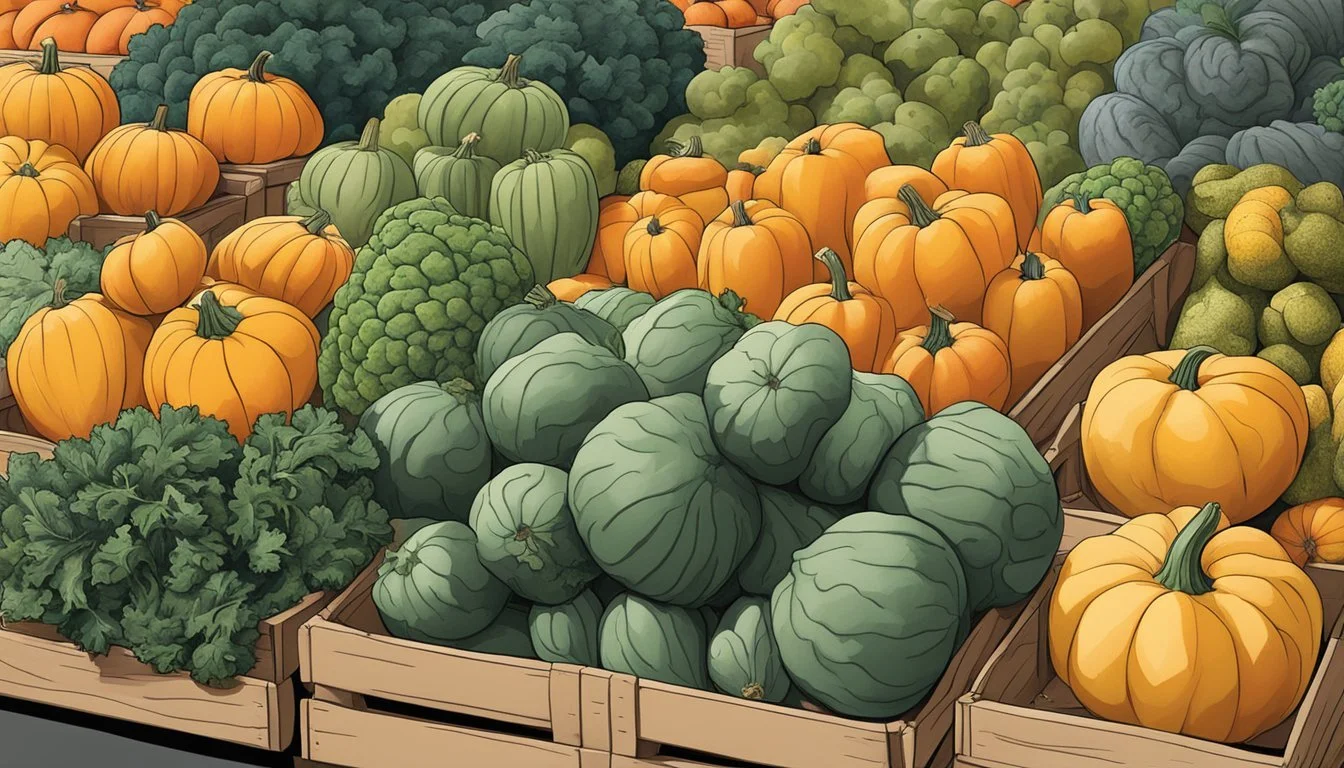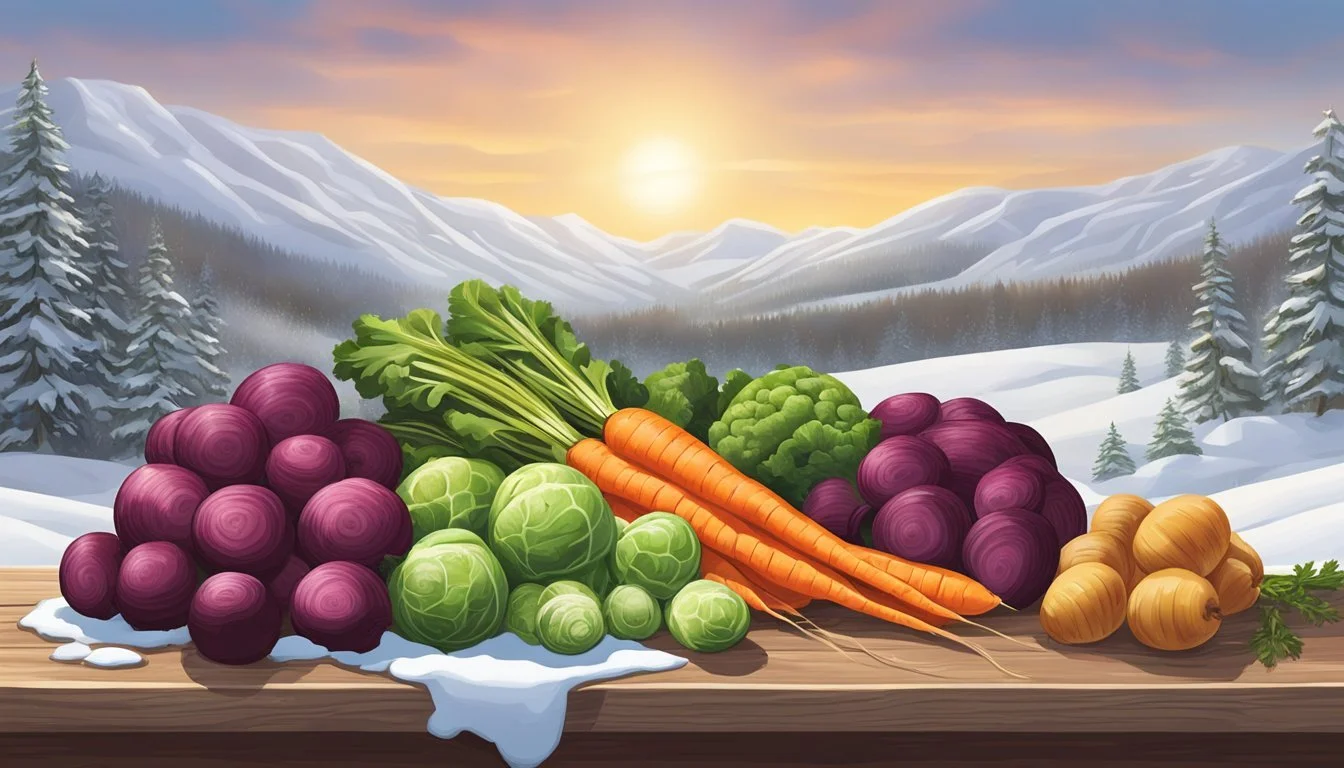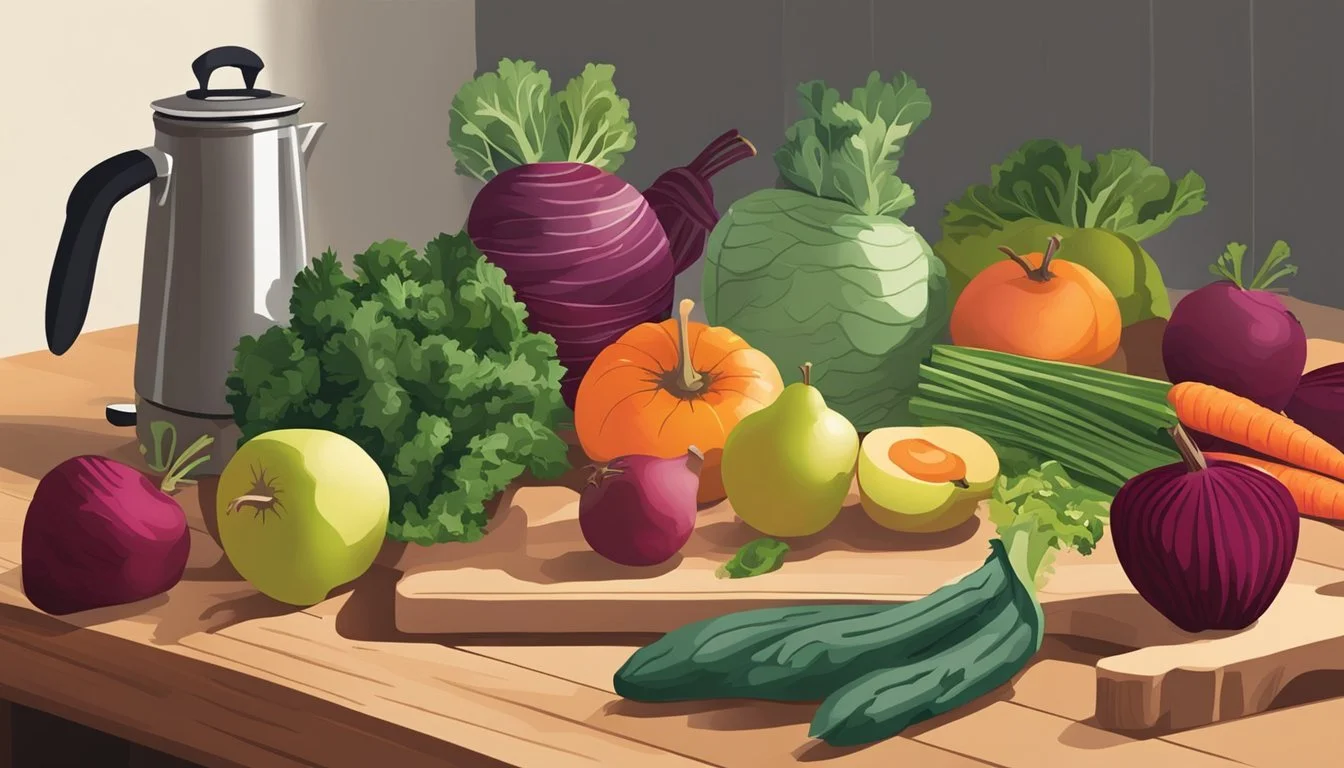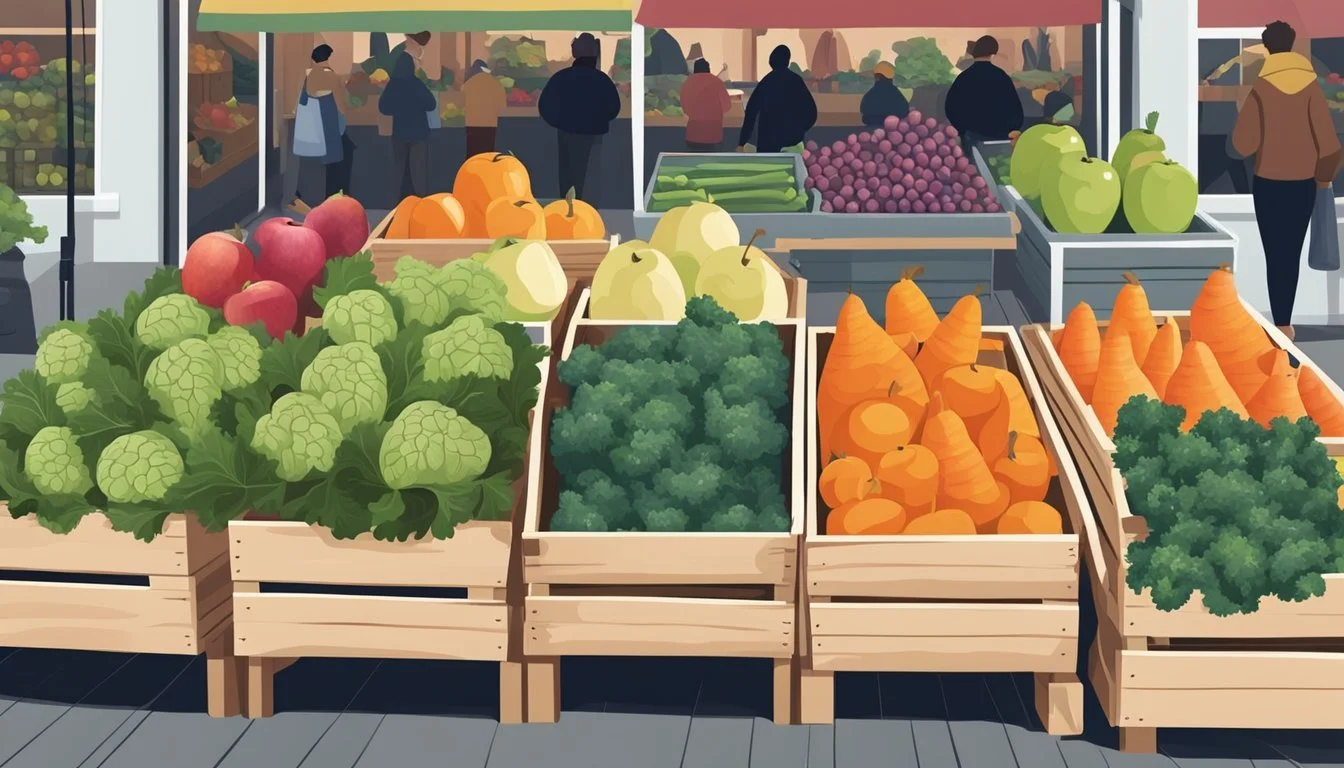Rhode Island Seasonal Fruit & Vegetables in February
A Fresh Guide to Eating Locally
This Article is Part of our Rhode Island Seasonal Fruit & Veg Calendar
Rhode Island's winter season extends into February, a month that typically does not evoke images of abundant harvest. However, the state's residents and local chefs know that even during these colder days, there are fresh, seasonal fruits and vegetables to be enjoyed. February's offerings might be lean compared to the bountiful summer months, but there is still a variety of local produce available.
Seasonal eating in Rhode Island during February involves a selection of hearty vegetables and storage crops that are staples for winter meals. Root vegetables like potatoes and carrots, as well as winter squashes, are commonly found at farmers' markets or as part of community-supported agriculture (CSA) programs. These ingredients are versatile and provide a comforting, nutritional base for many dishes.
Greenhouses and indoor growing techniques also allow for the cultivation of certain fresh greens, such as spinach and kale, despite the chilly weather outdoors. While the fruit selection is more limited, stored apples from the previous autumn's harvest can often still be found, retaining their crispness and flavor. Embracing these seasonal offerings not only supports local agriculture in Rhode Island but also ensures that even in the heart of winter, the local diet can be both fresh and delicious.
Understanding Rhode Island's Seasonal Produce Cycle
Rhode Island's produce calendar navigates through distinct seasons, each presenting its own set of crops. February, a bridge between winter and spring, showcases a limited but valuable range of produce.
Winter to Spring Transition
During the transition from winter to early spring, Rhode Island's agricultural focus remains on cold-tolerant vegetables and stored crops from the previous fall harvest. By February, choices are often defined by storage capacity and winter-hardy varieties. Farmers employ season extension techniques, such as high tunnels and greenhouses, to protect and produce certain fresh vegetables. Early March marks the start of a gradual increase in variety as daylight extends and temperatures begin to rise.
Historical Harvest Patterns
Historically, Rhode Island's harvest patterns have dictated that spring crops are planted after the final frost, around May 15th, as per local agricultural guides. Meanwhile, fall frost typically lands around October 15th. This window frames Rhode Island's growing season, affecting what is available in February. Traditional practices have ensured that despite winter's challenges, including snowy conditions, there would be a rotation of produce consistent with the region's seasonal fluctuations.
Seasonal Vegetables in February
In Rhode Island, the chill of February continues to support a selection of hearty vegetables. Root vegetables, leafy greens, and cruciferous family members remain the mainstay of local produce this month.
Root Vegetables Availability
Root vegetables thrive in Rhode Island's cold weather, offering a bounty of nutritious options. Beets (how long do beets last?) and carrots, with their deep hues, provide antioxidants and are readily available. Parsnips and turnips, versatile in cooking, add a sweet, earthy flavor to winter dishes. Potatoes and onions, staples in many cuisines, continue to be abundant. Finally, garlic, an essential flavor enhancer, is also a part of the seasonal harvest.
Beets: Robust and sweet, suitable for roasting and boiling.
Carrots: Crunchy, full of beta-carotene.
Parsnips: Sweet when roasted, good for soups and purees.
Turnips: Starchy alternative to potatoes, good for stews.
Potatoes: In variety; used boiled, mashed, or roasted.
Onions: Flavor foundation for many dishes.
Garlic: Pungent, used to elevate savory flavors.
Leafy Greens Selection
The selection of leafy greens during February is impressive, retaining much of their quality despite the colder temperatures. Kale and collards stand out for their robust textures, which makes them perfect for hearty stews and soups. Spinach, tender and mild-flavored, is versatile in both cooked dishes and fresh salads. An array of these greens continues to be available at local markets.
Kale: Nutrient-dense, ideal for chips and sautéed dishes. (What Wine Pairs Best with Sautéed Dishes)
Collards: Great for long-cooking recipes.
Spinach: Delicate and flavorful, for salads and sautés.
Cruciferous Vegetables in Season
Cruciferous vegetables like cabbage, cauliflower (how long does cauliflower last?), and Brussels sprouts offer a combination of health benefits and versatility. Their presence in the local markets is strong in February. Cabbage can be used fresh in slaws or cooked in various dishes, while cauliflower roasts well and can be transformed into creamy purees. Brussels sprouts are delightful roasted or pan-seared, with a flavor that becomes sweeter post-frost.
Cabbage: Crisp, used raw or cooked.
Cauliflower: Mild, good as a low-carb substitute.
Brussels sprouts: Nutty, especially delicious when caramelized.
February's Seasonal Fruits
Rhode Island in February showcases a variety of fruits that are sweet and tart, perfect to brighten up the winter palate. This section will guide you through which fruits are in season during this brisk month.
Winter to Early Spring Fruits
In Rhode Island, February is a prime month for enjoying a range of citrus fruits. These include:
Lemons: A staple for both culinary and beverage uses, offering a strong, zesty flavor.
Blood Oranges: Noted for their deep red flesh, these fruits have a unique berry-like taste compared to other oranges.
Limes: Essential for a touch of acidity in dishes and drinks, with a sharp, refreshing taste.
Citrus fruits are not only delicious but also packed with Vitamin C, which is crucial for immune system support during the colder months.
Storage and Late Harvest Fruits
Certain fruits are available due to late harvest and storage capabilities, which include:
Apples: Stored from fall, there's a wide variation in taste among different varieties from tart to sweet.
Pears: With proper cold storage, these fruits maintain their buttery and sweet flavor.
Apples and pears stored from the previous harvest season provide fruit options that remain fresh due to controlled atmosphere storage technology, enabling them to retain their taste and nutritional value.
Local Rhode Island Produce
In February, consumers in Rhode Island can still enjoy a range of locally grown produce, despite the chill of winter. Dedicated farmers employ sustainable methods to deliver fresh and organic options direct from farm to table.
Farm to Table: Fresh Picks
Winter Farmers Markets: Rhode Island's winter farmers markets provide locally-sourced produce, including winter squashes, potatoes, and greenhouse-grown greens. These markets support the farm-to-table movement by connecting consumers directly with farmers.
Greenhouse Greens: Look for spinach, kale, and other leafy greens, which are grown in local greenhouses during the winter months.
Root Vegetables: Potatoes, parsnips, and carrots are often available and offer robust flavors and hearty meal options.
Organic and Sustainable Options
Organic Farming: Local organic farms in Rhode Island comply with strict guidelines, ensuring no synthetic pesticides or fertilizers are used. This results in a cleaner product that supports the health of both people and the planet.
Sustainable Practices: Farms often use crop rotation, cover cropping, and composting to maintain soil health.
Certification: When purchasing, look for the "certified organic" label to ensure produce meets organic standards.
Local Rhode Island farms operate with the community and environment in mind, providing fresh, sustainable, and organic choices throughout the seasons.
Cooking with February Produce
When cooking with February produce in Rhode Island, chefs and home cooks can take full advantage of a diverse and hardy selection of vegetables that are in season. From root vegetables to cruciferous greens, there are abundant ingredients available for creating warming winter dishes.
Seasonal Recipes and Preparation
Root Vegetables: Root vegetables like beets, carrots, parsnips, and potatoes are versatile and can be incorporated into a variety of recipes. They can be roasted to enhance their natural sweetness or puréed into soups for a creamy texture. Beets work well in salads or pickled as a condiment, while carrots and parsnips can be sautéed for a simple side dish.
Roasted Beets: Toss with olive oil, salt, and roast until tender.
Carrot and Parsnip Soup: Sauté in butter, then simmer with stock until soft. Blend until smooth.
Cruciferous Vegetables: Seasonal greens like kale, brussels sprouts, and cabbage thrive in colder temperatures and can be used in hearty meals. Kale is excellent in soups or massaged for salads, brussels sprouts can be roasted for a caramelized edge, and cabbage is perfect for slaws or sautéed as an accompaniment.
Kale and White Bean Soup: Incorporate into a broth with cannellini beans (how long do cannellini beans last?) and herbs.
Sautéed Cabbage: Soften in a pan and season with caraway seeds (how long do caraway seeds last?) for added flavor.
Mushrooms: A wide variety of mushrooms are available and can be used in risottos, stews, or simply sautéed as an umami-packed side dish.
Mushroom Risotto (What wine goes well with mushroom risotto?): Cook with arborio rice, broth, and parmesan cheese for a creamy texture.
Winter Comfort Foods
The cold month of February calls for comfort foods that warm the heart and body. Using in-season produce to make traditional comfort dishes not only brings exceptional flavor but also nutritional benefits.
Soups and Stews: Vegetables like leeks, onions, and celeriac add depth to winter soups and stews. They can be slowly cooked to develop the flavors and blended for smoothness or left chunky for a rustic feel.
Potato Leek Soup: Combine with potatoes and blend for a creamy and comforting soup.
Roasted Dishes (What wine goes well with roasted dishes?): Many February vegetables are ideal for roasting, which intensifies their natural sweetness and brings out their best flavors.
Roasted Root Vegetables: Cut into chunks, toss with herbs, and roast until golden brown.
Braised Greens: Hearty greens such as collards can be braised with a bit of stock and seasonings like garlic and chili flakes to create a flavorful side dish that pairs well with proteins.
Braised Collard Greens (how long do collard greens last?): Cook slowly with bacon, onion, and chicken stock until tender.
Utilizing in-season produce in February in Rhode Island offers not only a fresh and local eating experience but also the chance to enjoy traditional winter comfort foods made with the finest ingredients.
Beyond Produce: Seasonal Foods
In February, Rhode Island's bounty extends beyond produce into a variety of other fresh and local food sources. These options include a selection from the ocean's harvest as well as farm-fresh meats, poultry, and unique regional products like honey and herbs.
Seafood, Meats, and Poultry
Rhode Island waters are teeming with seafood in February, offering a fresh catch that's synonymous with New England's culinary identity.
Seafood: This month, cod and tuna are excellent choices due to their winter availability. They can be sourced from local fishermen who brave the cold Atlantic waters.
Meats: While many may associate livestock with warmer months, February still provides high-quality meat options. Locally raised meats like beef and pork are available, with farmers often using this season to offer cuts from animals raised during the past year.
Poultry: Chicken and ducks are year-round staples on Rhode Island farms. Winter poultry is often richer in flavor, as the birds have been maturing throughout the fall.
Seasonal Herbs and Other Products
Despite the cold, some hardy herbs continue to thrive, and other unique products are highlighted during this season in Rhode Island.
Herbs: Growers utilize greenhouses and indoor setups to cultivate herbs like thyme and rosemary, which can impart a fresh taste to winter dishes.
Other Products:
Honey: Local apiaries may have harvested honey in the late summer and early fall, making February an ideal time to enjoy this natural sweetener with a complex flavor profile influenced by Rhode Island's diverse flora.
Eggs: Hens generally lay fewer eggs in winter, making the eggs available in February a prized commodity for their freshness and rich yolks.
By exploring these seasonal foods, one can celebrate Rhode Island's array of local offerings even during the chill of February.
Shopping for Seasonal Foods
In Rhode Island during February, individuals interested in seasonal foods can explore a variety of fresh local produce by visiting nearby markets and farm stands. Knowledge of local harvest times and identification of ripe produce are key to maximizing one's shopping experience.
Finding Local Markets and Stands
Travelers and residents can locate numerous seasonal farmers markets throughout Rhode Island that offer a diverse range of fresh produce, even during the winter months. These markets typically highlight harvests from local farms and may also offer other goods like seafood, cheese, and baked items. One can shop for seasonal items with various payment options, including cash, credit, and EBT. Here is a list of some common seasonal items available in Rhode Island markets during winter:
Winter Squash: Various types including butternut and acorn
Apples: Stored from fall harvest and still fresh
Greens: Hardy varieties such as kale and collards
Root Vegetables: Including potatoes, carrots, and turnips
Tips for Choosing the Best Produce
When selecting produce, shoppers should look for fruits and vegetables that are firm, have vibrant colors, and are free of significant blemishes or soft spots. Checking the stems and leaves can also be indicative of freshness, especially in greens and herbs. Here are some tips to keep in mind:
Apples: Should feel firm and heavy for their size without any wrinkling on the skin.
Greens: Leaves should be crisp and not wilted, with a bright green color.
Root Vegetables: Should be firm and clean, avoid any with sprouting or a spongy texture.
By engaging with local farmers and vendors, shoppers may also glean insights into how the produce was grown and receive suggestions for selecting the best items.








